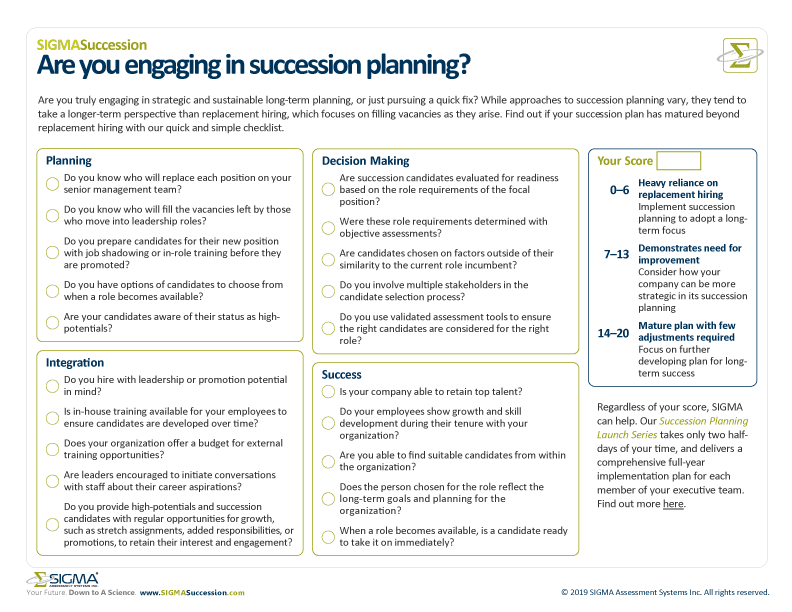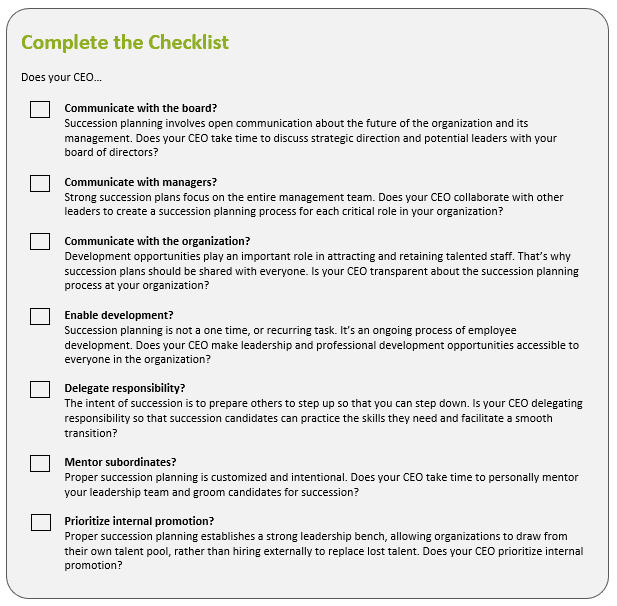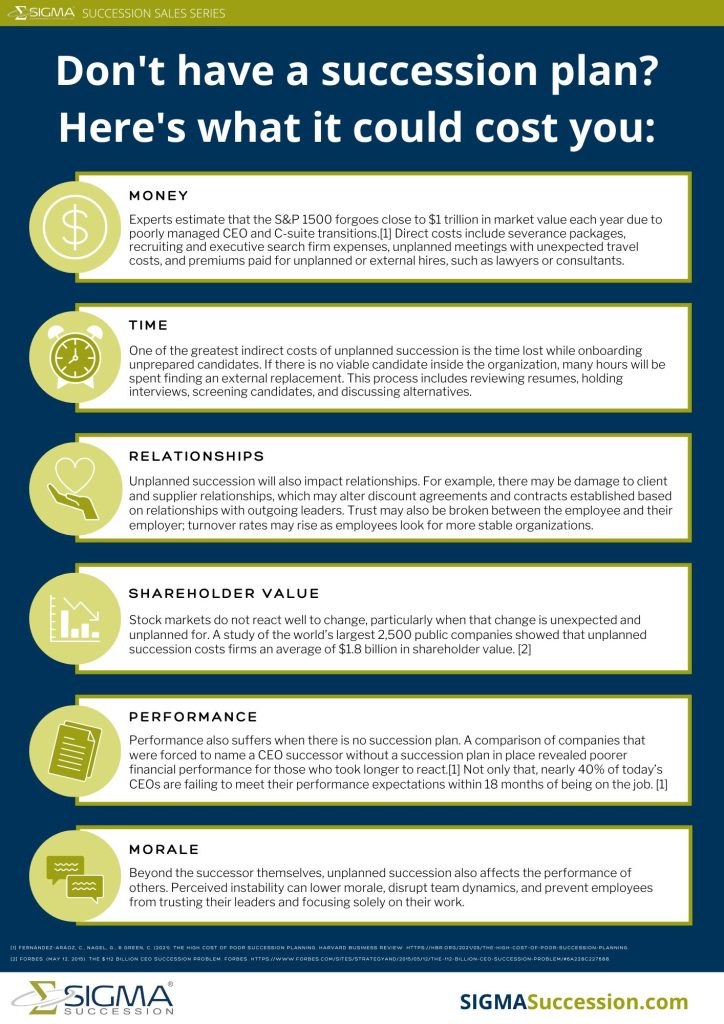Five Reasons CEOs Get in the Way of Succession
It should come as no surprise that a successful succession planning process demands an engaged and supportive CEO. In fact, we will not deliver our Succession Planning Launch Series unless the CEO is in the room for both sessions. Without CEO support, succession plans often fail to gain enough attention, resources, or priority to truly benefit an organization. With this in mind, we thought we’d discuss a few reasons why your CEO might be getting in the way of succession planning.
As we discussed in previous videos, succession planning requires the engagement of your CEO. Without the support, succession initiatives fail to gain the attention, resources, or priority needed to be effective. Today, we’re going to discuss some common reasons why CEOs stand in the way of succession planning, and some solutions to address these challenges.
First, some CEOs don’t see the value of succession planning. They may express worry that it will be too difficult or provide a distraction from day to day tasks. Not only does this indicate that the CEO does not value succession planning, but also that they may fail to recognize the risk associated with not having a plan in place. The best way to address this issue is to make it real. Showing your CEO the urgent need for succession planning by having them complete our quick At-A-Glance Org Chart. This visual tool can help you to identify two things. First, areas where you are at risk of personnel loss. And second, a lack of replacement readiness in your company. Show your CEO where your company is most vulnerable to highlight the importance of having a robust plan in place.
Next, some CEOs are hesitant to engage in formal succession planning because they believe they have the process under control. This typically takes the form of having someone in mind for critical roles. This informal method is called replacement planning, which can be seen as unfair and based on favoritism rather than on objective decision making. To turn a replacement plan into a succession plan, complete our Audio Engaging in Succession Planning Checklist. Drive home to your CEO that replacement planning is hard on employee morale, reduces transparency in decision making, and fails to provide development opportunities for promising employees. Challenge your leader to think outside the replacement plan by considering who would fill a critical role if the incumbent and their top replacement choice were to leave tomorrow.</p>
<p>Finally, even CEOs who understand the value of succession planning can hesitate to actually enact one in their company. As with any long term strategic process, succession planning can be intimidating to begin and some CEOs feel that all the responsibility of creating a plan will fall onto their shoulders. Help your CEO out by presenting them with a user-friendly but robust process, such as SIGMA’s Simple Succession Plan. Consider partnering with an experienced external consultant. Succession planning is not something a CEO needs to go through alone, and the right consultant can help you through any stage of the process. By leveraging our At-A-Glance Org Chart and Audio Engaging in Succession Planning Checklist, you can begin to gain your CEOs buy-in for succession. For more valuable resources, visit us at sigmasuccession.com or contact us today.
1. They don’t see the value of succession planning
CEOs who don’t see the value of succession planning will evade, postpone, or abandon the process for a variety of reasons. You may hear your CEO saying that
- Succession planning distracts from day-to-day priorities
- Planning for succession takes too much time
- Planning for succession costs too much money
- Establishing a succession planning process is too complicated
- No critical roles are projected to be vacant soon
- The company already has enough strong leaders to promote internally
- Even if the company cannot promote internally, top talent can always be recruited externally
Having these concerns demonstrates that your CEO doesn’t understand the value of succession planning, let alone the cost of not having a plan.
2. They see their position as permanent
Last year, in the United States alone, over 1,600 CEOs left their position. This exceeds the 1,257 CEOs who exited in 2008 during the Great Recession and is the highest turnover recorded since outplacement firm Challenger, Gray & Christmas, Inc. began tracking CEO departures in 2002.[1]
Clearly no CEO lasts forever; turnover, sickness, and retirement are inevitable. However, most CEOs take on their role with aspirations for their tenure, not plans for their departure. Your CEO’s intention to remain with the company may bias them away from engaging in long-term succession planning. As a result, years go by without a succession plan in place, not only for the CEO, but for the senior management team at large.
3. They believe they have succession planning all under control
When asked about their succession planning process, many CEOs think they’re on track if they have someone in mind for each leadership role. More often than not, that ‘someone in mind’ is simply the result of the successor’s long-term relationship with the incumbent. This model for succession lacks any kind of formal process for identifying qualified succession candidates and developing their potential. In fact, promoting an incumbent CEO’s personal protégé is little more than an embellished form of replacement hiring.
CEO’s who believe they have succession under control also make the mistake of keeping succession plans to themselves. A proper succession plan should always be a company-wide initiative. Therefore, CEOs must involve the board, senior management, and the candidates themselves as they are groomed to step into the businesses’ most critical role.
4. They’ve mistaken what succession planning is
SIGMA has worked with organizations across North America for more than 50 years, and we’ve seen that it’s not uncommon for leaders to mistake what succession planning truly is. More often than not, leaders confuse replacement hiring for succession planning. In other cases, they underestimate the role that coaching and employee development plays in a proper succession planning process. In essence, succession planning is about building a leadership pipeline. This pipeline will develop a strong leadership bench from which your company can draw as needed to keep critical roles in the organization filled with capable, internal talent. If that doesn’t sound like it’s worth the cost, we don’t know what is!
Are you worried you might be replacement hiring rather than succession planning? Take a look at this Succession Planning vs. Replacement Hiring Checklist to make sure you’re on track.

5. They don’t know where to start
Before assuming the worst, consider that you might also have a CEO who understands the value of succession planning, but just doesn’t know where to start. It’s natural to focus our attention on urgent tasks with immediate risk and reward, but this can lead us to neglect important duties, such as planning for the long-term stability of the company. If this is the case for your CEO, present them with a simple process, such as SIGMA’s Succession Planning Process. Finally, consider using an experienced succession consultant, who can offer succession workshops, templates, and resources to guide your process.
Is Your CEO Getting in the Way of Succession?
If you think there’s a need for succession planning in your organization, you’re probably right. Use this checklist to see whether your CEO is standing in the way of succession and take a look at our tips for how you can get your CEO on board.

The Cost of Not Having a Plan
Not sure if succession planning is worth the cost? Take a look at the summary below to see what the cost of unplanned succession may be. Download the infographic and use this data to get your CEO and other senior leaders on board to invest in the succession planning process.

Download Infographic: The Cost of Not Having a Succession Plan
Ready to Get Started?
Are you ready to start building your succession planning process? Take a look at how you can sell succession to your CEO, or contact us below for more information on how we can help your leaders prepare for tomorrow.
[1] Challenger, Gray & Christmas, Inc. (2019). 2019 Year-End CEO Report: 160 CEOs Out in December, Highest Annual, Quarterly Totals On Record. Challenger, Gray & Christmas, Inc. http://www.challengergray.com/press/press-releases/2019-year-end-ceo-report-160-ceos-out-december-highest-annual-quarterly-totals.
